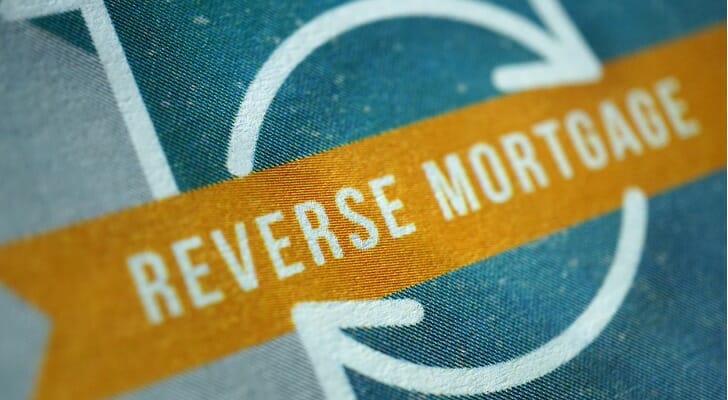A reverse mortgage is a financial instrument that allows seniors who are 62 and older to borrow against the value of their homes. Maybe their family home has been where they raised their children, but they are now empty-nesters and it’s far too big. If the seniors have a lot of equity built up in their homes, they can tap their equity to help with their cash flow. Getting a reverse mortgage is one way to do that. Here’s what you need to know about reverse mortgages. A financial advisor can help you weigh the pros and cons of a reverse mortgage.
What Is a Reverse Mortgage?
A reverse mortgage accesses the equity you have built up in your home and converts it to cash payments to you. Your home serves as collateral. Payments to you from a reverse mortgage are simply an advance on the equity you would receive from your home if you sold it outright. These payments are usually not taxable.
Unlike a traditional mortgage where your mortgage shrinks as you make your payments, the reverse mortgage balance grows as you tap your equity to receive cash payments. For this reason, a reverse mortgage is similar to a home equity line of credit (HELOC).
Besides being at least 62, applicants for reverse mortgages must own their homes, have sufficient equity and live in it as their primary residence. Your spouse should always be included in a reverse mortgage application. Even if your spouse is less than 62 years of age, include them on the application as a “non-borrowing” spouse. In this way, if you pass away while there is a balance left on the loan, your spouse may remain in the home.
Usually, one of the requirements of the reverse mortgage is that you must use the proceeds of the reverse mortgage to pay off the existing mortgage on the house, if there is an existing mortgage. Besides that, you can use the proceeds of the reverse mortgage as you see fit.
The Cost of Reverse Mortgages
Reverse mortgages are expensive mortgages with lots of pros and cons. They typically have high costs associated with them. For starters, there are costs for counseling that you must receive prior to obtaining a reverse mortgage. That cost is based on your ability to pay.
Then, you have initial costs that can be paid in cash or rolled into your loan. If they are rolled into your loan, your loan payments back to you over the life of the loan are reduced.
Initial costs:
- Mortgage origination fee – paid to the lender and not to exceed $6,000.
- Real estate closing costs – similar to a traditional mortgage and includes an appraisal of your home, title search, recording fees, home inspection, taxes and any other fees required by your lender.
- Mortgage insurance premium – this is the initial charge that insures you will receive your loan payments.
Ongoing costs:
Interest and fees are added to the interest and fees from the previous month. In other words, interest compounds up, unlike traditional mortgages where interest compounds down.
Some other features include:
- Annual mortgage insurance premium: 0.05% of your outstanding mortgage balance.
- Property charges: homeowner’s insurance, flood insurance, taxes, other charges if applicable.
When Does a Reverse Mortgage Come Due?
The reverse mortgage loan does not come due until you die, move out of the home or stop paying the property taxes, hazard insurance and other ongoing costs associated with the mortgage.
You keep up with your property taxes and other costs and remain in your home. You have a federally insured reverse mortgage. When you die, the home goes into foreclosure and the bank takes it back. FHA insurance covers it.
If the value of the house far exceeds the loan value, the heirs can pay off the house and keep the remaining money.
If you fail to keep the house maintained or don’t keep up with your property taxes and other costs, the home can go into foreclosure.
The costs of reverse mortgages and what happens at the end of the term of the reverse mortgage are two of the most significant factors you should focus on before signing on the dotted line. If you apply and are approved for a reverse mortgage, you have a three-day “right of rescission” after you sign the paperwork, meaning you have three days to cancel and not be held liable for the reverse mortgage.
There is also an insurance product that doubles as “reverse mortgage insurance.” It is called private mortgage insurance. You can get it through your lender or another insurance agent.
The Home Equity Conversion Mortgage (HECM)
There are three types of reverse mortgages. The most popular reverse mortgage loan is the home equity conversion mortgage (HECM). The HECM is popular because it is federally insured by the Federal Housing Administration (FHA). It is likely to be more expensive than a traditional mortgage. Before a loan can be made, the home has to be appraised. Before you apply for a HECM, you must meet with a counselor so you will understand the costs and benefits of this type of loan.
The amount you can borrow with a HECM depends on a variety of factors:
- Your home must be worth less than $822,375 and the amount should be verified by an appraisal.
- You have to be able and willing to pay both property taxes and insurance on the home for the life of the loan.
- If interest rates are rising, the amount of HECM you will receive will be less.
- You cannot be delinquent on federal debt, including income tax debt.
If you meet these conditions, then here are the property requirements under FHA:
- The property must meet all FHA property standards and flood requirements.
- The property can be a single unit house or a 2-4 unit house if the owner lives in one of the units.
- The property can be a HUD-approved condominium project.
- The property can be a manufactured house if it meets HUD requirements.
Financial requirements for the borrower:
- Income, assets, monthly living expenses and credit history will be verified.
- Whether you have paid property taxes, homeowner’s insurance and flood insurance will be verified.
Costs of HECM Reverse Mortgages

The major cost of a HECM reverse mortgage is the interest cost. A variable-rate interest reverse mortgage is usually better than fixed interest if you have a traditional mortgage to pay off. If you opt for a variable rate loan, you can draw payments off a line of credit. For a fixed-rate loan, the amount available to you is much more limited and available only as a lump sum payment.
Calculating the interest rate is similar to the calculation for other types of mortgages, except the age of the owner is a factor. Current market rates and the lending institution comes into play as factors in interest rate calculations. The good news is that interest payments are not due until the owner leaves the property.
If current market interest rates are rising, you will get less of your principal at closing. The lending institution will protect itself against foreclosure.
The HECM Saver Program was first offered in 2010 by Housing and Urban Development to help those who couldn’t apply for a reverse mortgage due to the high upfront costs.
Under the HECM Saver program, homeowners receive about 10% to 18% less in principal amount than under the standard HECM loan. However, their upfront mortgage insurance premium is lowered to 0.01% of the property’s value instead of the standard 2%.
Other Types of Reverse Mortgages
There are two other types of reverse mortgages that are less common than the HECM reverse mortgage. Neither of them are federally insured.
Single-Purpose Reverse Mortgage
The single-purpose reverse mortgage is the least expensive reverse mortgage. Single-purpose reverse mortgages are offered by some state and local governments along with some nonprofit agencies. This type of reverse mortgage is meant for one purpose and that purpose is specified by the lender. It may be for property taxes or to help pay for home repairs, to name only two possibilities.
This type of reverse mortgage is the cheapest of all of them. The single-purpose reverse mortgage does not have to be repaid unless the borrower dies, moves to a different primary residence or sells the home. The mortgage will come due if the borrower stops paying the property taxes on the home or stops maintaining the home. It is not a very common type of reverse mortgage, but low- and middle-income consumers can qualify for it.
Proprietary reverse mortgages
A proprietary reverse mortgage is used when a borrower’s income is at the other end of the spectrum from those who apply for single-purpose reverse mortgage loans. Proprietary reverse mortgages are obtained through private lenders and are not federally insured. They are for high-net-worth individuals with a home worth more than $822,375.
This type of reverse mortgage has no mortgage insurance, so borrowers may have a higher interest rate than on the other types of reverse mortgage loans. It’s also possible that the private lender will require some type of credit counseling. Both are basically private mortgage programs offered through private lenders for specific types of borrowers.
Reverse Mortgage Scams
The reverse mortgage industry has been plagued by scams. Reverse mortgages are a financial product used by scammers to target the elderly. Some scams that have been used with regard to the elderly and reverse mortgages are:
- Foreclosure scam: Scammers target seniors who are in danger of losing their homes to foreclosure. They convince the homeowner that a reverse mortgage will help them and use a dishonest appraiser. After the mortgage is approved, they have the title to the home transferred to them and that leaves the homeowner without a home or the proceeds from the reverse mortgage.
- Fake financial institution scam: The scammer works with a fake financial institution and, during the closing, has the title transferred to them.
- Document fraud: There are many forms of document fraud. One is to charge seniors thousands of dollars for information about reverse mortgages that is freely available.
In order to protect yourself from reverse mortgage scams, the Federal Bureau of Investigation (FBI) has tips for you to follow.
The Bottom Line
 Reverse mortgages let people over the age of 62 withdraw equity from their homes to help meet expensese. There are several types of reverse mortgages, some of which are not federally insured. Before getting a reverse mortgage you should understand all costs entailed in such a move and be alert to scams that seek to take advantage of elderly home owners. Reverse mortgages aren’t the only way to withdraw equity from your home; refinancing is another option.
Reverse mortgages let people over the age of 62 withdraw equity from their homes to help meet expensese. There are several types of reverse mortgages, some of which are not federally insured. Before getting a reverse mortgage you should understand all costs entailed in such a move and be alert to scams that seek to take advantage of elderly home owners. Reverse mortgages aren’t the only way to withdraw equity from your home; refinancing is another option.
Tips on Retirement
- Maybe you need a financial advisor to help you determine whether or not to obtain a reverse mortgage. Finding a qualified financial advisor doesn’t have to be hard. SmartAsset’s free tool matches you with up to three financial advisors in your area, and you can interview your advisor matches at no cost to decide which one is right for you. If you’re ready to find an advisor, get started now.
- Before you consider reverse mortgages you should get a solid estimate of whether you have the resources to retire – without the income of a reverse mortgage. Use our free retirement calculator for a quick estimate of that figure.
Photo credit: ©iStock.com/Kameleon007, ©iStock.com/Credit:Andrii Yalanskyi, ©iStock.com/Dean Mitchell
